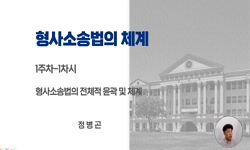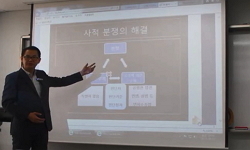This study examines the changes in the characteristics of serving ancestors(奉祀) and heir-naming(立後) during the Joseon dynasty based on the records of a dispute over service rights between the descendants of first-born son and those of second-b...
http://chineseinput.net/에서 pinyin(병음)방식으로 중국어를 변환할 수 있습니다.
변환된 중국어를 복사하여 사용하시면 됩니다.
- 中文 을 입력하시려면 zhongwen을 입력하시고 space를누르시면됩니다.
- 北京 을 입력하시려면 beijing을 입력하시고 space를 누르시면 됩니다.

조선시대 衆子奉祀를 둘러싼 인식의 변화― 18세기 후반 정탁 후손의 봉사권 분쟁 자료를 중심으로 ― = The Changes in the Perception Surrounding on Serving Dead Parents by a Son Other than the First-Born Son in Joseon— Based on the Records of the Dispute over Service Rights of the Descendants of Jeong Tak in the Late 18th Century —
한글로보기부가정보
다국어 초록 (Multilingual Abstract)
Based on the idea of serving dead parents just like when they were living, any child could be entitled to perform the worship rite for their parents in early Joseon. Therefore, it was common for fathers to designate a son other than the first-born one and his own eldest son to serve, even though they would be serving according to Confucian ritual forms at that time. The act of having another son serve aside from the first-born son and his successor was regulated in the late 15th century, but the practice of having the next-born son serve if the first-born son died without a son of his own and leaving the decision of whether or not the naming heir to the first-born son’s widow continued to occur even afterward. Naming the heir in early Joseon meant establishing the heir for a sonless couple, and even if he was the heir of the first-born son, he was considered the first-born son and his wife’s heir not for the heir of the head family. Therefore Jeong Tak entrusted the service to his second-born son, Jeong Yun-wi when his first-born son died with no son, and the widow of the first-born son, Jeong Yun-jeo, named Jeong Si-young as the heir for the couple 38 years after her husband's death and 19 years after the second-son began the service of Jeong Tak.
However, in the late 18th century, the descendants of the first-born son’s heir claimed that Jeong Yun-wi’s service was just a proxy based on the fact that their direct ancestor, Jeong Si-young, was the first-born son's heir, and filed a lawsuit to take over the right to serve Jeong Tak, which had been performed by his second-born son and his descendants for 169 years. Against this claim, the second-born son’s descendants even argued that naming Jeong Si-young as the first son’s heir was obtained through illegal means. Both sides misunderstood and distorted on how the decision was made the one of serving Jeong tak and characteristics of the heir of Jeong Yun-jeo to fit the late 18th-century notion of family succession centered on the first-born son, which was strengthened.
This study examines the changes in the characteristics of serving ancestors(奉祀) and heir-naming(立後) during the Joseon dynasty based on the records of a dispute over service rights between the descendants of first-born son and those of second-born son of Jeong Tak in the late 18th century.
Based on the idea of serving dead parents just like when they were living, any child could be entitled to perform the worship rite for their parents in early Joseon. Therefore, it was common for fathers to designate a son other than the first-born one and his own eldest son to serve, even though they would be serving according to Confucian ritual forms at that time. The act of having another son serve aside from the first-born son and his successor was regulated in the late 15th century, but the practice of having the next-born son serve if the first-born son died without a son of his own and leaving the decision of whether or not the naming heir to the first-born son’s widow continued to occur even afterward. Naming the heir in early Joseon meant establishing the heir for a sonless couple, and even if he was the heir of the first-born son, he was considered the first-born son and his wife’s heir not for the heir of the head family. Therefore Jeong Tak entrusted the service to his second-born son, Jeong Yun-wi when his first-born son died with no son, and the widow of the first-born son, Jeong Yun-jeo, named Jeong Si-young as the heir for the couple 38 years after her husband's death and 19 years after the second-son began the service of Jeong Tak.
However, in the late 18th century, the descendants of the first-born son’s heir claimed that Jeong Yun-wi’s service was just a proxy based on the fact that their direct ancestor, Jeong Si-young, was the first-born son's heir, and filed a lawsuit to take over the right to serve Jeong Tak, which had been performed by his second-born son and his descendants for 169 years. Against this claim, the second-born son’s descendants even argued that naming Jeong Si-young as the first son’s heir was obtained through illegal means. Both sides misunderstood and distorted on how the decision was made the one of serving Jeong tak and characteristics of the heir of Jeong Yun-jeo to fit the late 18th-century notion of family succession centered on the first-born son, which was strengthened.
참고문헌 (Reference)
1 문숙자, "조선후기 祭祀承繼 방식의 선택과 의미-兄亡弟及을 선택한 淸州鄭氏家의 사례-" 한국사학회 (77) : 205-235, 2005
2 박경, "조선시대 입양과 가족제도" 혜안 2011
3 "연산군일기"
4 "승정원일기"
5 "수교집록"
6 "세종실록"
7 "세조실록"
8 "성종실록"
9 "선조실록"
10 "변무사적"
1 문숙자, "조선후기 祭祀承繼 방식의 선택과 의미-兄亡弟及을 선택한 淸州鄭氏家의 사례-" 한국사학회 (77) : 205-235, 2005
2 박경, "조선시대 입양과 가족제도" 혜안 2011
3 "연산군일기"
4 "승정원일기"
5 "수교집록"
6 "세종실록"
7 "세조실록"
8 "성종실록"
9 "선조실록"
10 "변무사적"
11 "명종실록"
12 "대전후속록"
13 "대명률"
14 "국조방목"
15 "경국대전"
16 청주 정씨 대동보 간행위원회, "淸州鄭氏大同譜"
17 지두환, "朝鮮前期 儀禮硏究 –性理學 正統論을 中心으로-" 서울대학교출판부 1994
18 鄭肯植, "朝鮮初期 祭祀承繼法制의 成立에 관한 硏究" 서울大學校 大學院 1996
19 김윤정, "朝鮮中期 祭祀承繼와 兄亡弟及의 변화" 조선시대사학회 (20) : 107-130, 2002
20 이순구, "朝鮮中期 冢婦權과 立後의 강화" 9・10 : 1996
21 고민정, "『繼後謄錄』의 기술방식과 法外繼後에 대한 재검토" 한국사학회 (113) : 199-236, 2014
22 고민정, "17~18세기 兄亡弟及의 사례를 통해 본 가계계승의 실현과정" 한국사학회 (140) : 255-288, 2020
23 "1776년 예조 결급 입안"
24 박경, "15세기 입후법(立後法)의 운용과 계후입안(繼後立案)" 한국역사연구회 (59) : 129-158, 2006
동일학술지(권/호) 다른 논문
-
바얀의 시대와 고려왕권― 「乞比色目表」와 「請同色目表」 작성 배경 ―
- 이화여자대학교 이화사학연구소
- 최윤정
- 2023
- KCI등재
-
- 이화여자대학교 이화사학연구소
- 박용진
- 2023
- KCI등재
-
- 이화여자대학교 이화사학연구소
- 이효진
- 2023
- KCI등재
-
중국 마르크스주의 역사학의 민족담론 분석― 뤼전위(呂振羽)의 민족사 연구를 중심으로 ―
- 이화여자대학교 이화사학연구소
- 최은진
- 2023
- KCI등재




 KCI
KCI KISS
KISS







